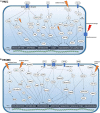Transcription factors in the pathogenesis of pulmonary arterial hypertension-Current knowledge and therapeutic potential
- PMID: 36684555
- PMCID: PMC9853303
- DOI: 10.3389/fcvm.2022.1036096
Transcription factors in the pathogenesis of pulmonary arterial hypertension-Current knowledge and therapeutic potential
Abstract
Pulmonary arterial hypertension (PAH) is a disease characterized by elevated pulmonary vascular resistance and pulmonary artery pressure. Mortality remains high in severe cases despite significant advances in management and pharmacotherapy. Since currently approved PAH therapies are unable to significantly reverse pathological vessel remodeling, novel disease-modifying, targeted therapeutics are needed. Pathogenetically, PAH is characterized by vessel wall cell dysfunction with consecutive remodeling of the pulmonary vasculature and the right heart. Transcription factors (TFs) regulate the process of transcribing DNA into RNA and, in the pulmonary circulation, control the response of pulmonary vascular cells to macro- and microenvironmental stimuli. Often, TFs form complex protein interaction networks with other TFs or co-factors to allow for fine-tuning of gene expression. Therefore, identification of the underlying molecular mechanisms of TF (dys-)function is essential to develop tailored modulation strategies in PAH. This current review provides a compendium-style overview of TFs and TF complexes associated with PAH pathogenesis and highlights their potential as targets for vasculoregenerative or reverse remodeling therapies.
Keywords: epigenetics; epigenetics (chromatin remodeling); pathogenesis; pulmonary hypertension (PAH); reverse remodeling; targeted therapy; transcriptomics.
Copyright © 2023 Körbelin, Klein, Matuszcak, Runge, Harbaum, Klose and Hennigs.
Conflict of interest statement
The authors declare that the research was conducted in the absence of any commercial or financial relationships that could be construed as a potential conflict of interest.
Figures


Similar articles
-
New Drugs and Therapies in Pulmonary Arterial Hypertension.Int J Mol Sci. 2023 Mar 19;24(6):5850. doi: 10.3390/ijms24065850. Int J Mol Sci. 2023. PMID: 36982922 Free PMC article. Review.
-
Epigenetic reactivation of transcriptional programs orchestrating fetal lung development in human pulmonary hypertension.Sci Transl Med. 2022 Jun 8;14(648):eabe5407. doi: 10.1126/scitranslmed.abe5407. Epub 2022 Jun 8. Sci Transl Med. 2022. PMID: 35675437
-
BMP type II receptor as a therapeutic target in pulmonary arterial hypertension.Cell Mol Life Sci. 2017 Aug;74(16):2979-2995. doi: 10.1007/s00018-017-2510-4. Epub 2017 Apr 26. Cell Mol Life Sci. 2017. PMID: 28447104 Free PMC article. Review.
-
Signal Mechanisms of Vascular Remodeling in the Development of Pulmonary Arterial Hypertension.J Cardiovasc Pharmacol. 2016 Feb;67(2):182-90. doi: 10.1097/FJC.0000000000000328. J Cardiovasc Pharmacol. 2016. PMID: 26448276 Review.
-
Novel Experimental Therapies for Treatment of Pulmonary Arterial Hypertension.J Exp Pharmacol. 2021 Aug 17;13:817-857. doi: 10.2147/JEP.S236743. eCollection 2021. J Exp Pharmacol. 2021. PMID: 34429666 Free PMC article. Review.
Cited by
-
5-Aminoimidazole-4-carboxamide ribonucleotide formyltransferase/inosine monophosphate cyclohydrolase promotes pulmonary arterial smooth muscle cell proliferation via the Ras signaling pathway.Am J Physiol Cell Physiol. 2024 Oct 1;327(4):C901-C912. doi: 10.1152/ajpcell.00262.2024. Epub 2024 Aug 12. Am J Physiol Cell Physiol. 2024. PMID: 39129491
-
Exploring hypoxia driven subtypes of pulmonary arterial hypertension through transcriptomics single cell sequencing and machine learning.Sci Rep. 2025 Apr 24;15(1):14251. doi: 10.1038/s41598-025-99025-5. Sci Rep. 2025. PMID: 40275058 Free PMC article.
-
Lung Single-Cell Transcriptomics Reveal Diverging Pathobiology and Opportunities for Precision Targeting in Scleroderma-Associated Versus Idiopathic Pulmonary Arterial Hypertension.Circ Genom Precis Med. 2025 Aug;18(4):e004936. doi: 10.1161/CIRCGEN.124.004936. Epub 2025 Jul 21. Circ Genom Precis Med. 2025. PMID: 40686216
-
A nomogram model for predicting maternal cardiovascular complications and neonatal adverse outcomes in pregnant patients with pulmonary arterial hypertension.Ann Med. 2025 Dec;57(1):2541093. doi: 10.1080/07853890.2025.2541093. Epub 2025 Aug 4. Ann Med. 2025. PMID: 40758664 Free PMC article.
-
Single-cell transcriptomics reveal diverging pathobiology and opportunities for precision targeting in scleroderma-associated versus idiopathic pulmonary arterial hypertension.bioRxiv [Preprint]. 2024 Oct 25:2024.10.25.620225. doi: 10.1101/2024.10.25.620225. bioRxiv. 2024. Update in: Circ Genom Precis Med. 2025 Aug;18(4):e004936. doi: 10.1161/CIRCGEN.124.004936. PMID: 39484590 Free PMC article. Updated. Preprint.
References
Publication types
LinkOut - more resources
Full Text Sources
Miscellaneous

